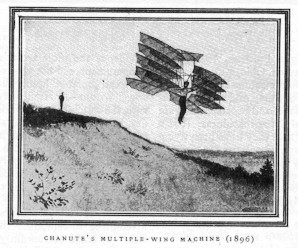Octave Chanute
Today, we meet the man who brought engineering to flying machines. The University of Houston's College of Engineering presents this series about the machines that make our civilization run, and the people whose ingenuity created them.
The American glider pioneer Octave Chanute and his assistants made their flights during the summers of 1896 and '97. He was 64 when they went to the sand dunes along southern Lake Michigan. They'd built, and they flew, the most advanced gliders before the Wright Brothers. One of them flew almost 400 feet. But Chanute wasn't cast in the mold of the early inventors of flight. He played a different kind of role.
He was a self-taught civil engineer, and a very good one. He'd become chief cngineer of the Erie Railroad by the time he was 41. Chanute's interest in flight began shortly after that. But he was a professional engineer, and -- more often than not -- people interested in flight were simply called crazy.
In 1885 Chanute went out on a limb. Surely flight was the province of professional engineers, he argued. So he organized a session on flight in the Mechanical Engineering part of the meeting of the American Academy for the Advancement of Science. He managed to get Robert Thurston, the most eminent mechanical engineer of the age, to write a paper for the session.
But the centerpiece of Chanute's session -- his keynote speaker -- was a disaster. He was a famous builder of model birds, and he served up bad science mixed with unbelievable theory. But no matter. Chanute had flung the issue of flight into the world of respectable science and engineering. From then on, he became a one-man clearing house for the international community of would-be fliers.
For years, Chanute sorted false claims form valid ones. He sifted among designs. He contributed his own money to other people's experiments. He labored selflessly and honestly to put humans into the sky. He brought a kind of honor to a field fraught with chicanery. When he finally flew his own gliders, they weren't really inventions. They were public demonstrations of the state of the art by the grand old man of aeronautics.
The Wright Brothers wrote to Chanute in 1900, when he was 68. It didn't take him long to see what dazzling genius those two quiet young men represented. He sent his own assistants to North Carolina to work with them. By 1902 the Wrights were making 600-foot flights in fully controllable gliders. The airplane was finally ready for its engines. The next year they took off and flew.
When the Wrights tangled in patent disputes, Chanute broke off with them. For him, technical information was a public commodity, and he hated secrecy. The relation was mending when Chanute died in 1910, and well it should have been. The Wrights and Chanute were all honorable men. They were the two opposite faces of engineering -- invention and expertise -- both at their very best.
I'm John Lienhard, at the University of Houston, where we're interested in the way inventive minds work.
(Theme music)
Crouch, T.D., A Dream of Wings: Americans and the Airplane 1875- 1905. Washington, D.C.: Smithsonian Institution Press, 1989.
This episode had been greatly revised as Episode 2702.

(From The Men Who Learned to Fly, 1908)
Octave Chanute aloft in 1896